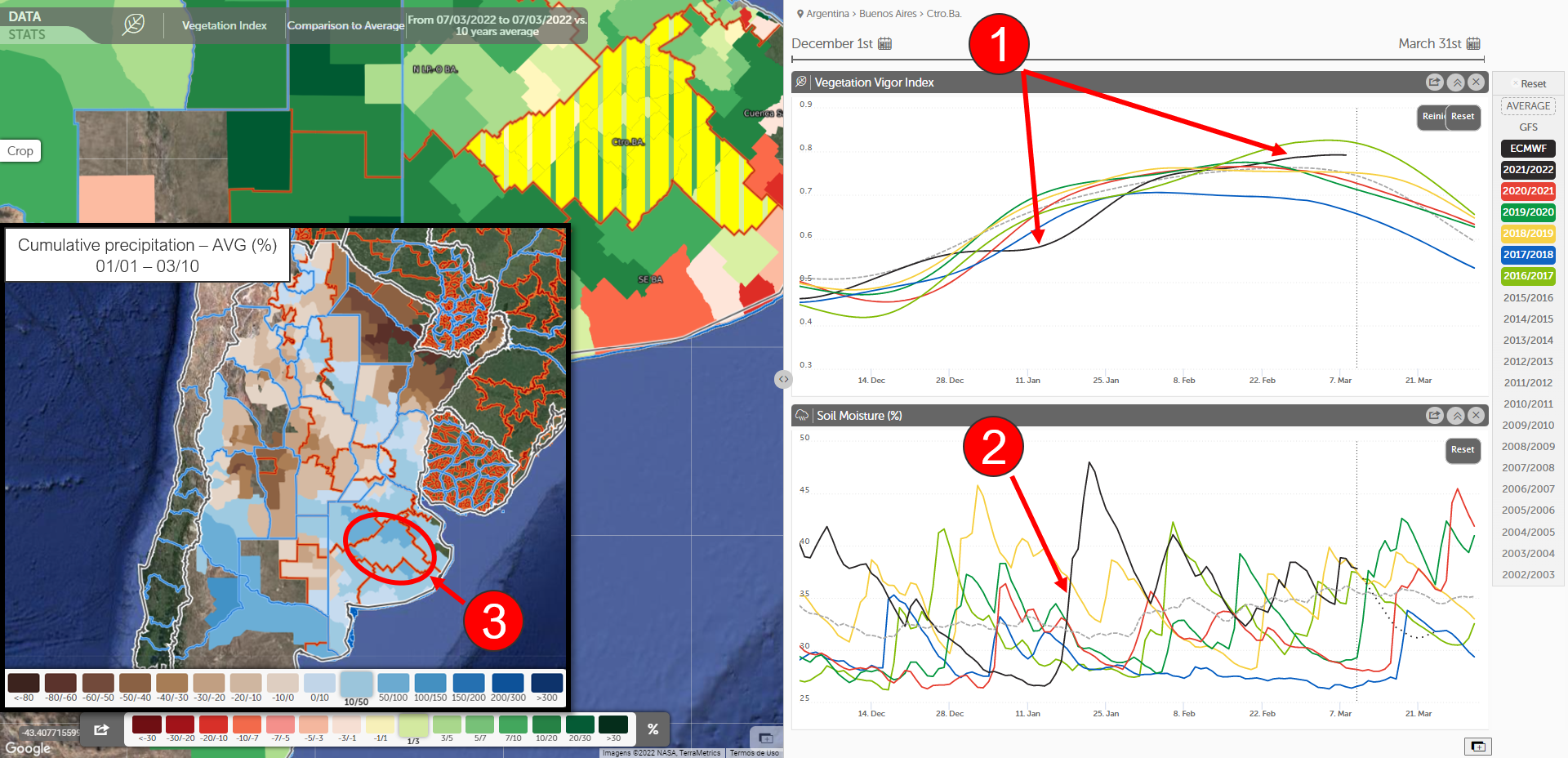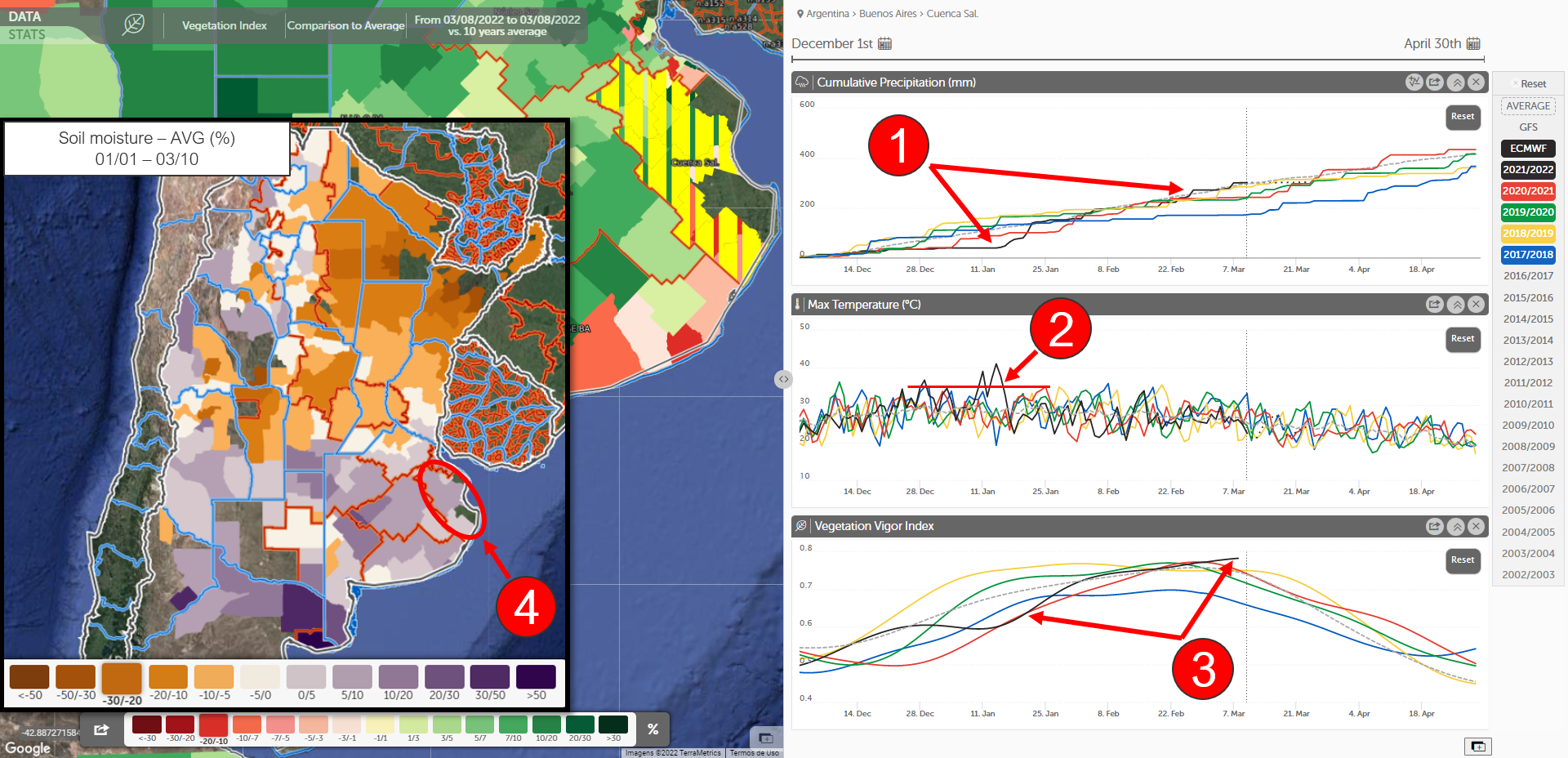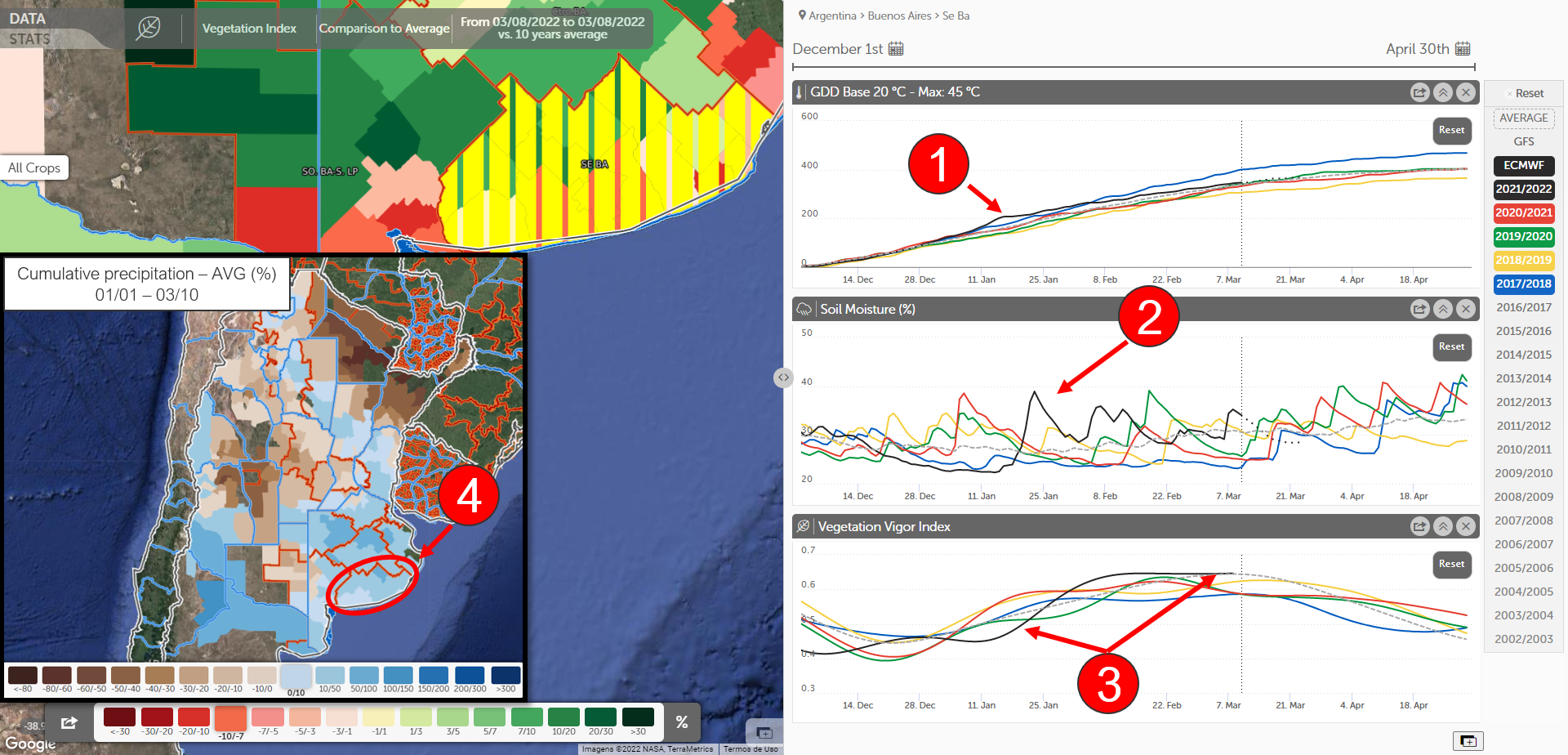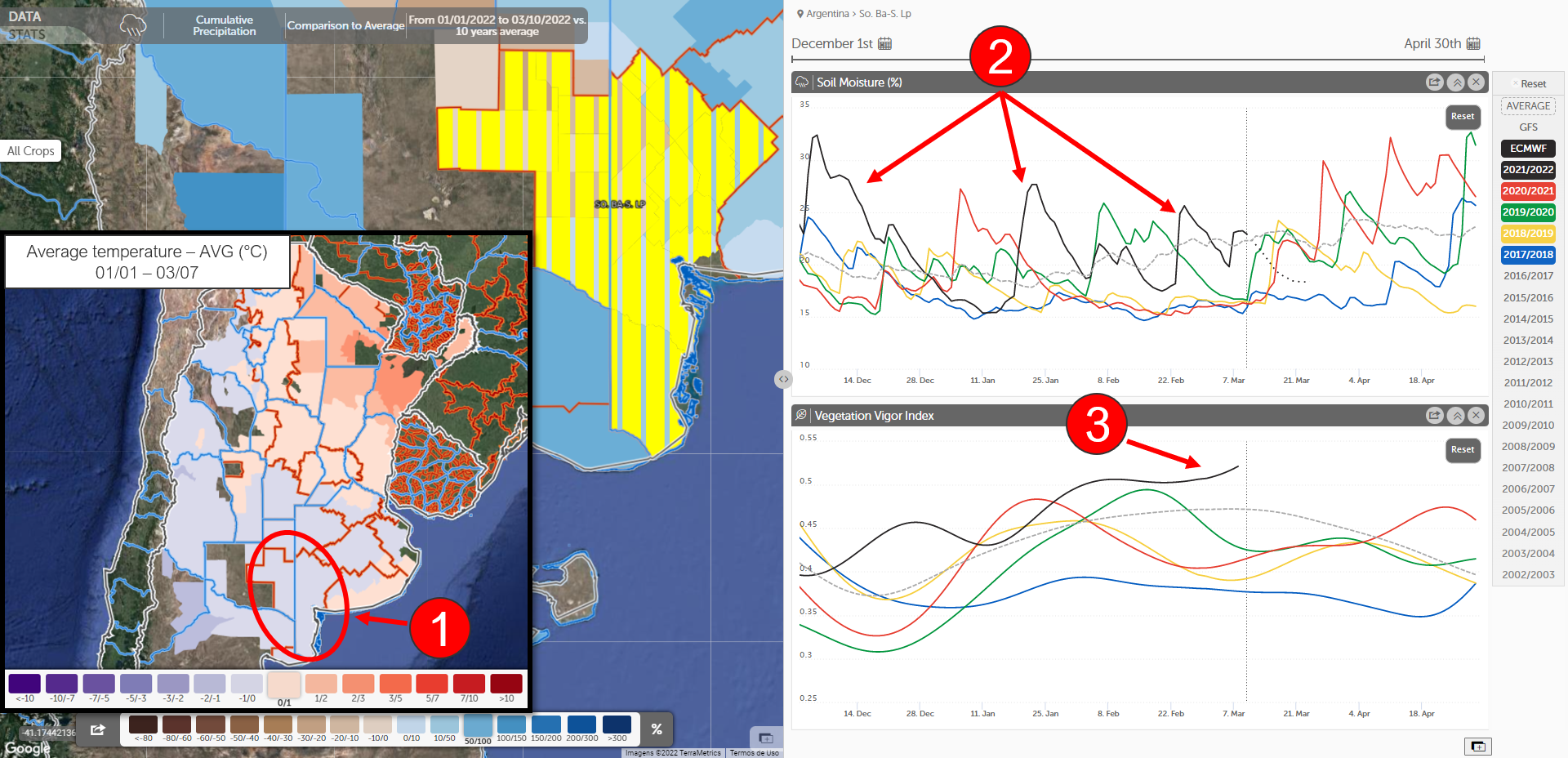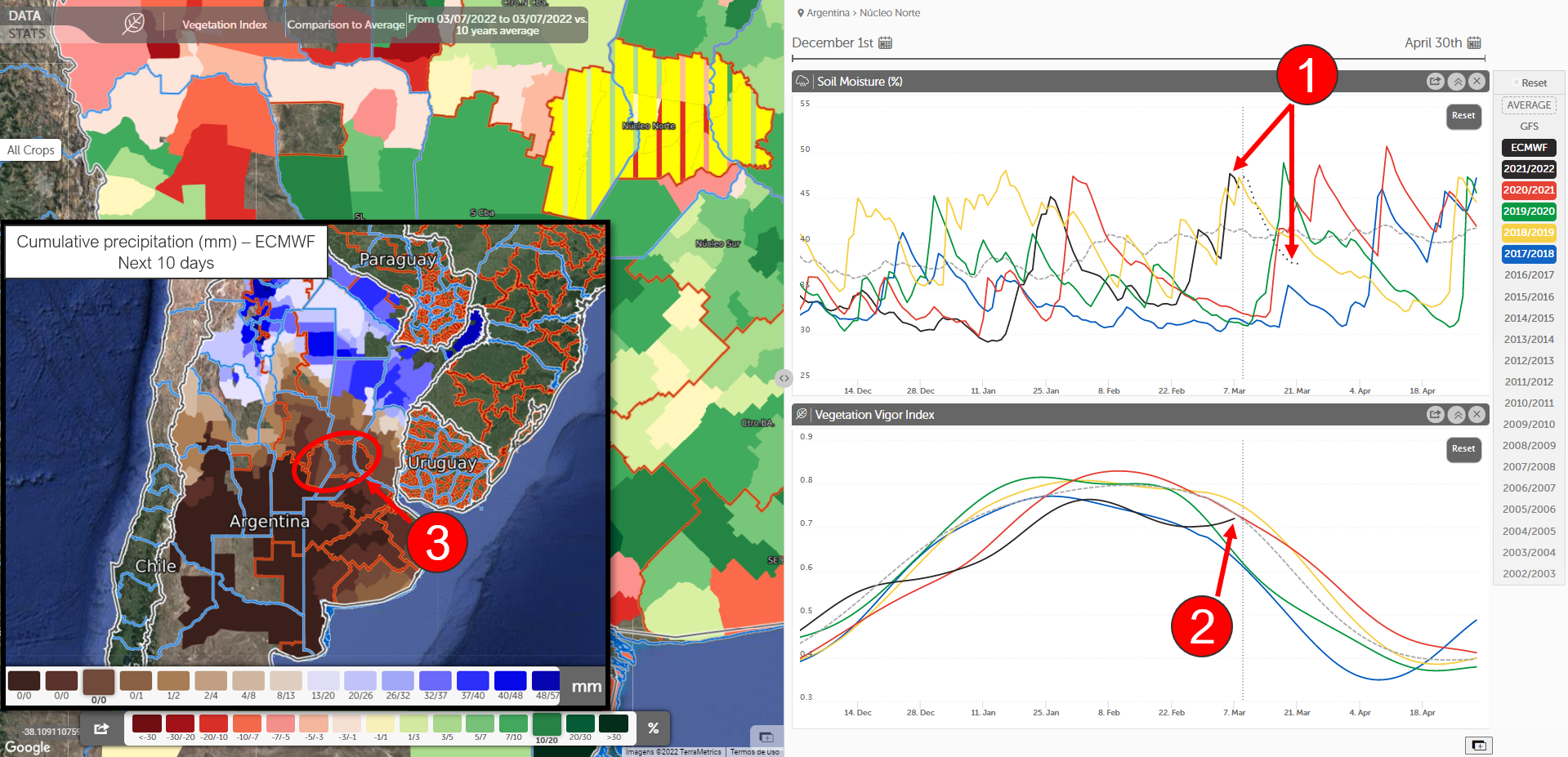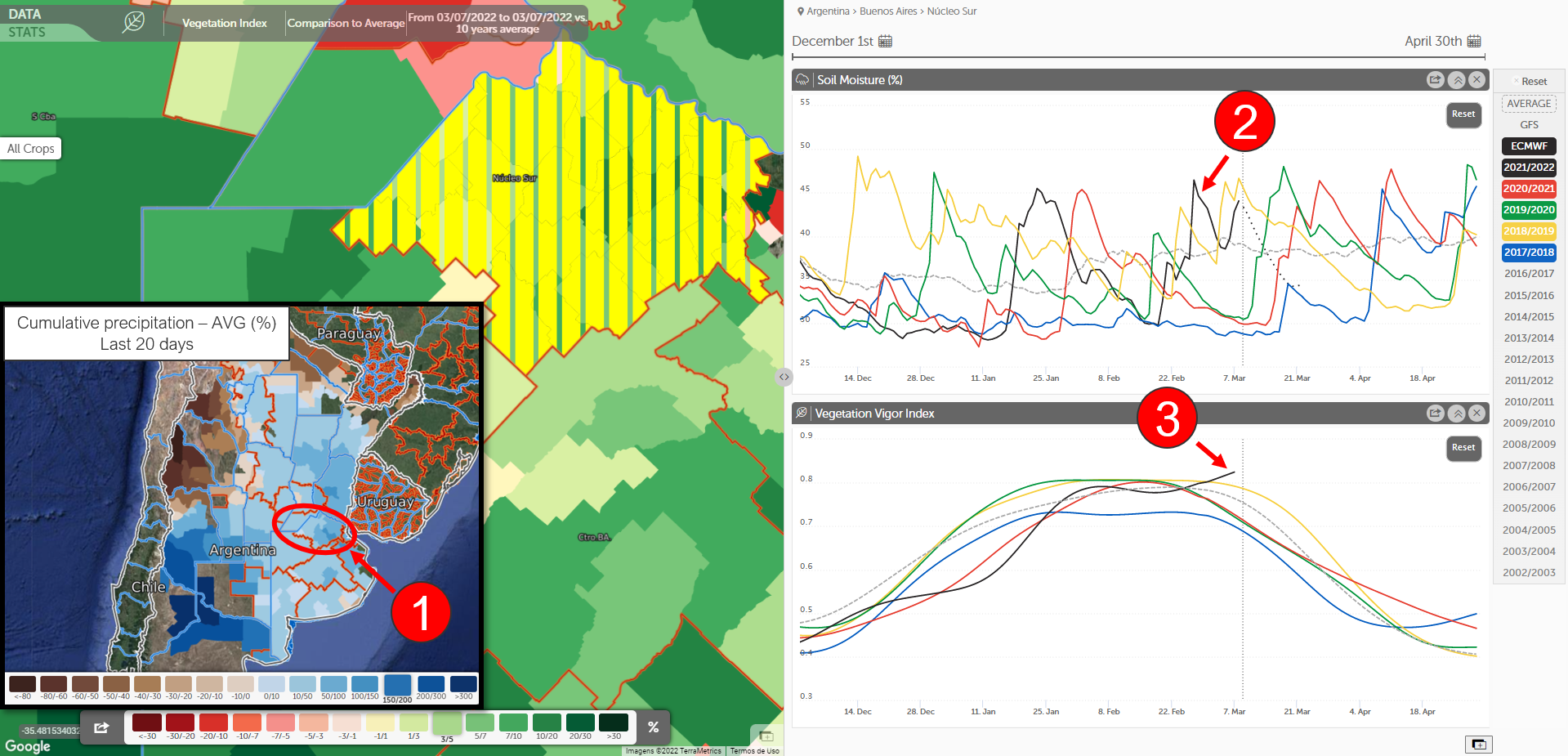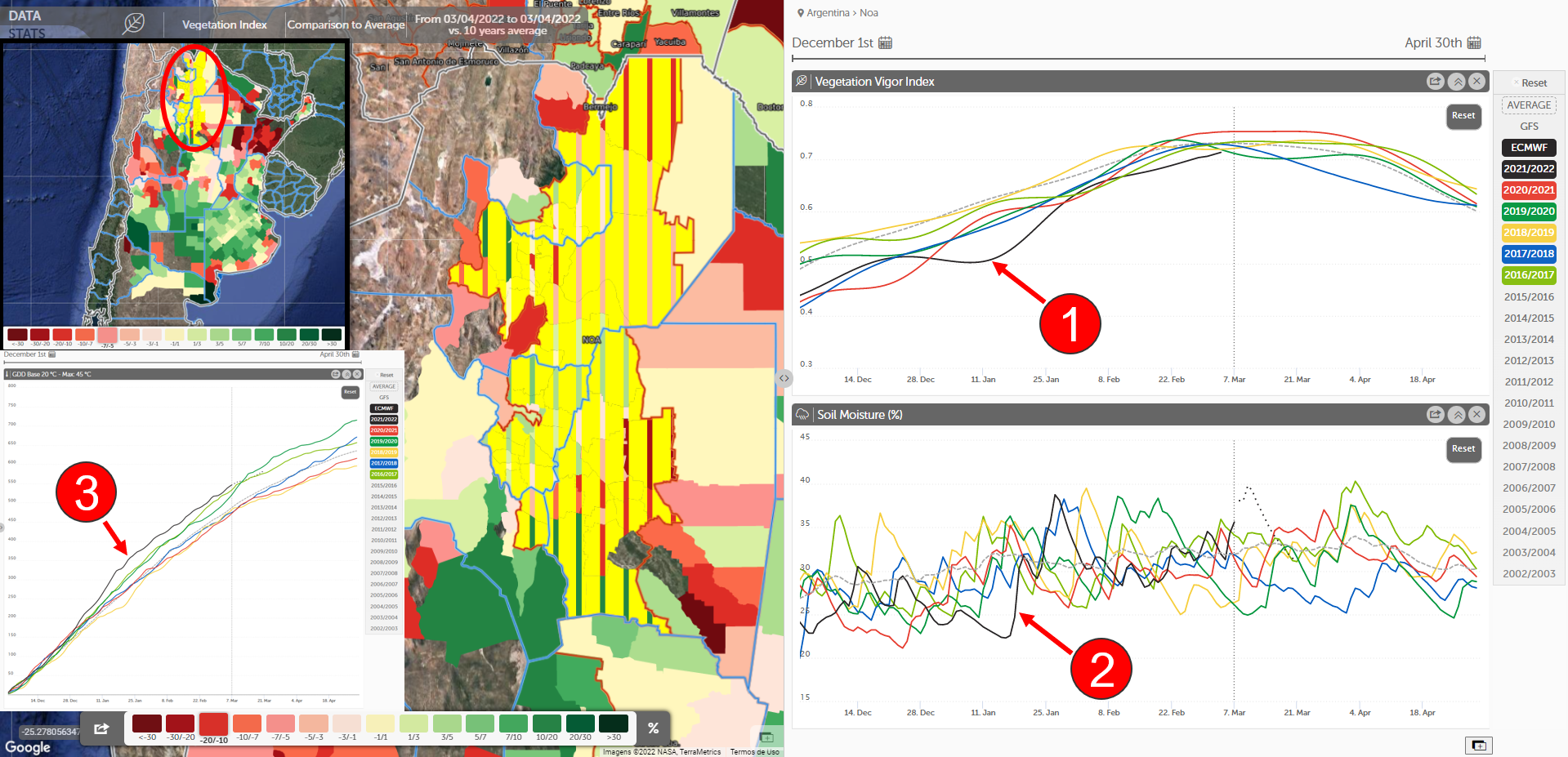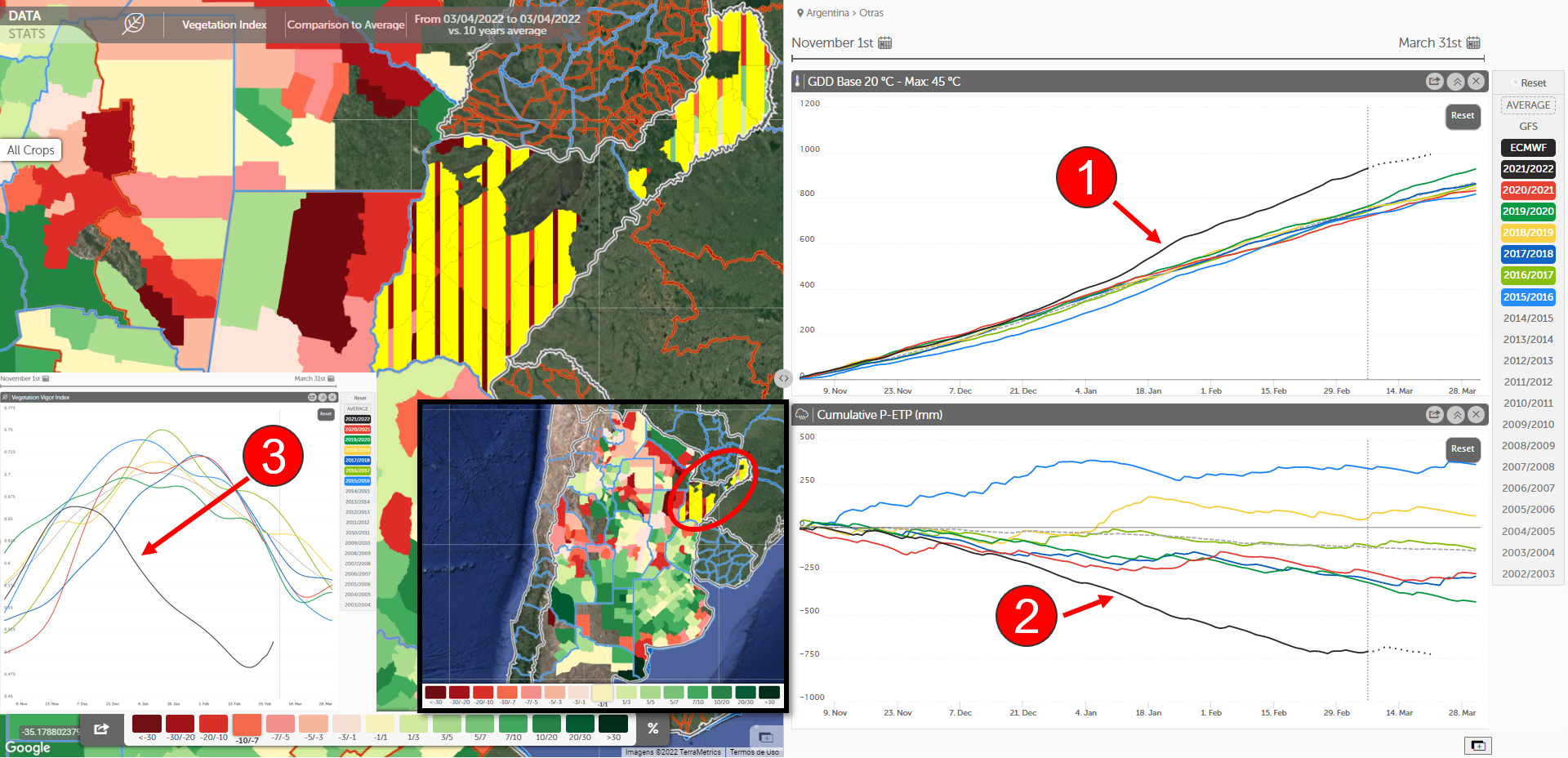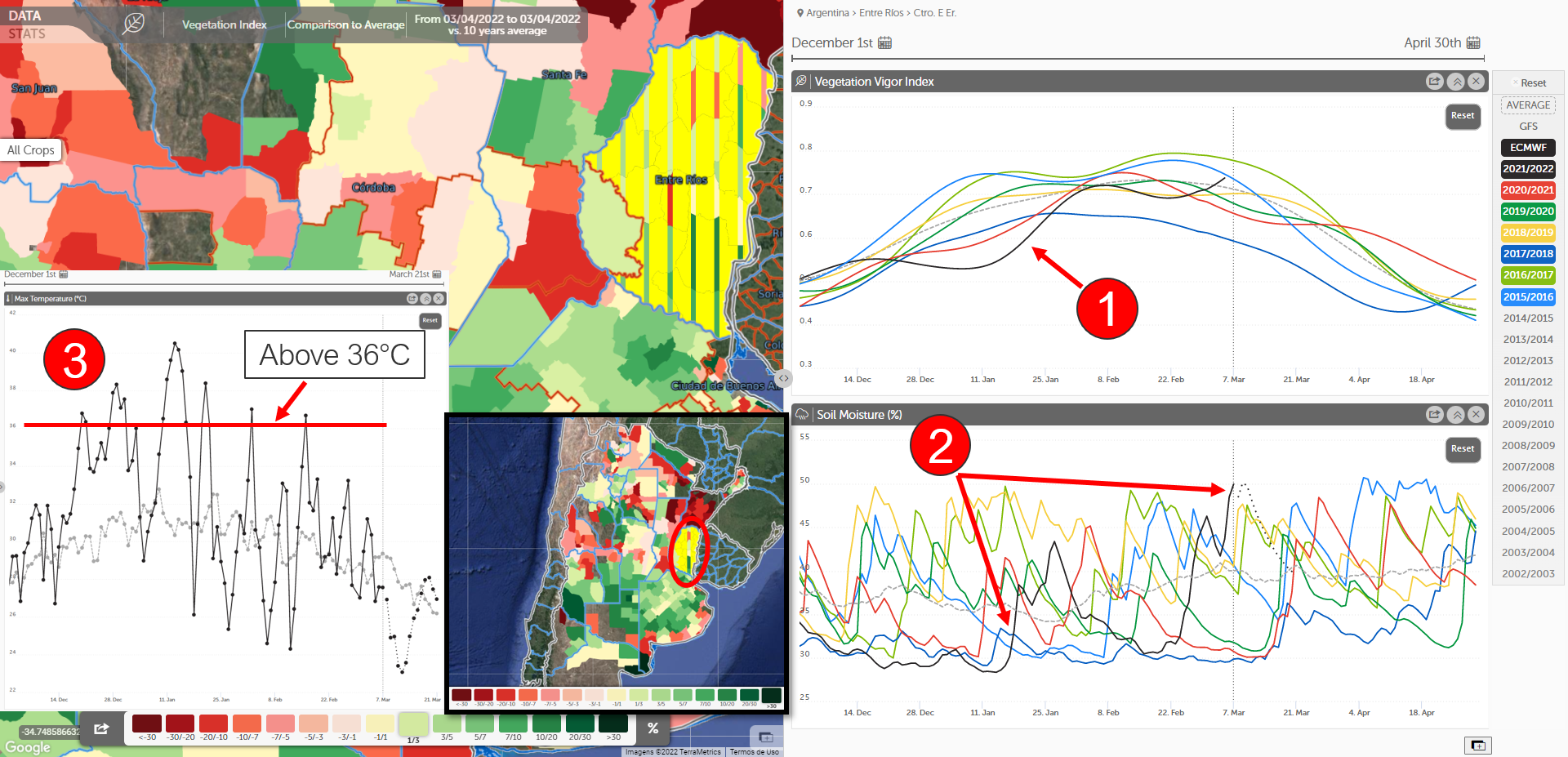
Virtual Crop Tour in Argentina 2022
Our team of crop analysts constantly monitor the world’s major growing regions. To understand what’s happening on the ground, we look to the sky by using scientific-grade satellite data to power industry-leading analytics.
The Virtual Crop Tour aims to check the current conditions of crops in Argentina and provide information on what to expect from crop production in the current season.
Day 5
Argentina – Will Argentina’s crop failure be the biggest in history? Why?
NO; LATE PLANTING
The bad weather conditions in December/21 and early this year limited the yield potential of the crops and had a negative impact on the vigor of the vegetation ①, but the return of the rains allowed the recovery of the NDVI, limiting the crop failure in the current season. With the greater precipitation, the soil moisture ② increased, crucial for the recovery of crops. In addition, in the current season, a good part of the soybean ③ and especially corn ④ crops were sown late, so the rains in late January and February came still in time to benefit these fields. For crops sown early, the drought had a higher impact, and the return of the rains had a smaller benefit. Currently, EarthDaily Agro estimates corn and soybean production at around 5.3% and 4.4% lower compared to last season. The fall in production in relation to the previous year would have been even greater, had it not been for the return of the rains this year, which mainly benefited late crops.
Day 4
Central Buenos Aires – Were all crops equally impacted by the drought at the beginning of the year?
NO
The vegetation indices ① had a poor dynamics at the beginning of this year, until mid-January, when the return of the rains and the increase in soil moisture ② allowed for a good recovery of the vigor of the crops. Considering since the beginning of the year, the cumulative precipitation ③ was 10 to 50% above the average, which confirms that the region did not have problems with drought like other areas. However, the low rainfall at the end of December and beginning of January had a greater impact on crops planted early, while late crops were able to make better use of the greater volume of water in February.
Cuenca del Salado – Is the crop failure compared to 2018?
NO
Despite bad conditions in late December and early January, with intense drought ① and temperatures above 35°C ② for several days in January, the NDVI ③ had good dynamics in February and March, due to increased soil moisture, which was above average (5 to 20%) ④ considering the last 70 days. The vegetation indices points to a much more favorable scenario this year compared to 2018.
South-East Buenos Aires – Did the rains come too late to restore the vigor of the crops?
NO
The high temperatures ① in January (even more associated with the drought) certainly reduced the yield potential of the crops, but the increase in soil moisture ② from the second half of January (with milder temperatures) allowed the recovery of the vegetation indices ③. It is important to say that the improvement of the conditions allowed the recovery of vigor more for the later crops than for those sown earlier. The cumulative precipitation ④ in the last 70 days was 10 to 50% above the average, which supports our theory of good condition for late crops.
South-West of Buenos Aires – South La Pampa – Should there be a strong crop failure in the region?
NO
In the region, temperatures ① were close to average, considering the last 70 days, and soil moisture ② was above average several times, conditions more favorable than in the north and east of the country. The NDVI ③ is at the highest level compared to the last few years since the end of January, which indicates that the bad conditions at the beginning of the year had a limited negative impact on the crops.
Day 3
North Central Santa Fe – Will conditions remain favorable in the short term?
YES
The return of the rains in February and the increase in soil moisture ① allowed for a good recovery of vegetation indices ② in recent weeks and, even with the trend of lower rainfall in the coming days, soil moisture ③ should remain above average in the short term, positive for crops.
North Belt – Was the rains in February positive to recover the vigor of the crops?
YES
The severe drought in December and early January had a negative impact on crops and reduced the yield potential of crops. However, the higher volume of rainfall in February resulted in an increase in soil moisture ① and allowed the recovery of the vegetation vigor indices ②, although the NDVI remains below average. For the next few days, the forecast is for low precipitation ③, which will result in a drop in soil moisture. To monitor.
South Belt – Was the return of the rains in February enough to recover the vigor of the crops?
YES
In the last 20 days, rainfall ① was 10 to 100% above the average. The higher soil moisture ② allowed the NDVI to recover in mid-January and again in late February and early March. The recovery of the vegetation indices ③ points to higher yield than in 2018 (bad year), for soybeans and corn.
North La Pampa – West Buenos Aires – Are conditions better than last season?
YES
Since the beginning of the year, on average, soil moisture ① was 5-20% above average. Cumulative precipitation ② is at the highest level compared to recent years. Vegetation indices ③ have been stable for weeks and had good dynamics for most of the cycle, unlike 2021 and 2018 (bad years). The forecast for the next few days is for low precipitation, but it’s no reason for concern for the short term.
Day 2
North-Central Cordoba – Is the drought recorded in the first months of this year more intense than that of 2018?
NO
Vegetation indices ① have been stable for weeks, in line with the average and at a higher level compared to the 2018 season since late January. The increase in soil moisture ② allowed for an improvement in the vigor of the vegetation and the tendency is for the moisture to remain at a level higher than that of 2018 in the short term. Monthly rains ③ show a drought in December, but a greater volume of rains in January and especially in February (in a month-to-month comparison with 2018). The NDVI is at a lower level than in the previous season, but much higher than in 2018, a year in which there was a strong crop failure. For the region, the estimate is that soybean yield will be higher than in 2018, but lower in the annual comparison.
South Cordoba – Is soil moisture likely to remain favorable in the short term?
NO
Low precipitation is expected for the next few days, which will result in a drop in soil moisture ①, however, moisture should remain at a much higher level compared to the 2018 season (year of strong crop failure). Even with the unfavorable conditions in the short term, the tendency is for the NDVI ② to remain at a higher level than in 2018, which indicates that yield should be higher this year.
San Luis – Could the drought in the next few days still affect the productive potential of crops?
YES
The low rainfall ① of the next few days can still reduce the yield potential of the crops, as occurred in 2018 ②, when the NDVI showed strong deterioration after the drop in soil moisture. However, soil moisture is expected to remain at a higher level than in 2018, although a drop below average is expected. We will monitor how the vegetation indices will behave with the expected drop in soil moisture for the next few days.
Day 1
Northwest Argentina (NOA) – Can improved water conditions completely reverse the damage caused by the drought at the beginning of the year?
NO
Vegetation indices ① had a very bad dynamic in late December and early January, due to low soil moisture ② and high temperatures ③. From the second half of January, water stress decreased, and soil moisture had a good increase in recent days, positive for crops planted late, however, crops planted early already had irreversible damage at this stage.
Northeast Argentina (NEA) – Should the water situation remain tense in the region?
NO
The return of the rains will result in an increase in soil moisture ① in the coming days, however, the soil moisture was at the lowest level in recent years, which shows the strong drought during most of the cycle, especially for crops planted early. The maximum temperatures ② in late December and early January were above 40°C several times, which also hampered the development of crops. NDVI ③ remains below the average of the last 10 years and at the second lowest level compared to the last 5 seasons. The improvement of conditions in the short term is favorable, but there are already irreversible damages in part of the crops.
Corrientes – Was the drought the most intense in recent years?
YES
In Corrientes, a region where soybean production is mostly sown early, the high temperatures ① during December and January were harmful to crops. The water balance ② (Precipitation – Evapotranspiration), was the lowest in recent years and evidences the severe drought. Vegetation indices ③ point to a strong crop failure in the current season.
East-Central Entre Ríos – Soil moisture should remain above average in the region?
YES
The vegetation indices ① showed very poor dynamics between December and January, mainly due to low soil moisture ② and high temperatures in the period ③. The unfavorable conditions had a strong negative impact on crops, especially those sown early. The improvement of conditions in recent days should favor crops sown late but should not reverse the scenario in crops sown early.


